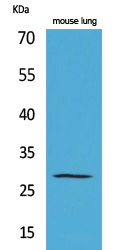Chymase Polyclonal Antibody
- Catalog No.:YT5123
- Applications:WB;ELISA
- Reactivity:Human;Rat;Mouse;
- Target:
- Chymase
- Fields:
- >>Renin-angiotensin system;>>Diabetic cardiomyopathy
- Gene Name:
- CMA1
- Protein Name:
- Chymase
- Human Gene Id:
- 1215
- Human Swiss Prot No:
- P23946
- Mouse Swiss Prot No:
- P21844
- Immunogen:
- Synthesized peptide derived from the Internal region of human Chymase.
- Specificity:
- Chymase Polyclonal Antibody detects endogenous levels of Chymase protein.
- Formulation:
- Liquid in PBS containing 50% glycerol, 0.5% BSA and 0.02% sodium azide.
- Source:
- Polyclonal, Rabbit,IgG
- Dilution:
- WB 1:500 - 1:2000. ELISA: 1:20000. Not yet tested in other applications.
- Purification:
- The antibody was affinity-purified from rabbit antiserum by affinity-chromatography using epitope-specific immunogen.
- Concentration:
- 1 mg/ml
- Storage Stability:
- -15°C to -25°C/1 year(Do not lower than -25°C)
- Other Name:
- CMA1;CYH;CYM;Chymase;Alpha-chymase;Mast cell protease I
- Observed Band(KD):
- 27kD
- Background:
- chymase 1(CMA1) Homo sapiens This gene encodes a chymotryptic serine proteinase that belongs to the peptidase family S1. It is expressed in mast cells and is thought to function in the degradation of the extracellular matrix, the regulation of submucosal gland secretion, and the generation of vasoactive peptides. In the heart and blood vessels, this protein, rather than angiotensin converting enzyme, is largely responsible for converting angiotensin I to the vasoactive peptide angiotensin II. Alternative splicing results in multiple variants. [provided by RefSeq, Apr 2015],
- Function:
- catalytic activity:Preferential cleavage: Phe-|-Xaa > Tyr-|-Xaa > Trp-|-Xaa > Leu-|-Xaa.,function:Major secreted protease of mast cells with suspected roles in vasoactive peptide generation, extracellular matrix degradation, and regulation of gland secretion.,similarity:Belongs to the peptidase S1 family.,similarity:Belongs to the peptidase S1 family. Granzyme subfamily.,similarity:Contains 1 peptidase S1 domain.,subcellular location:Mast cell granules.,tissue specificity:Mast cells in lung, heart, skin and placenta.,
- Subcellular Location:
- Secreted. Cytoplasmic granule. Mast cell granules.
- Expression:
- Mast cells in lung, heart, skin and placenta. Expressed in both normal skin and in urticaria pigmentosa lesions.
- June 19-2018
- WESTERN IMMUNOBLOTTING PROTOCOL
- June 19-2018
- IMMUNOHISTOCHEMISTRY-PARAFFIN PROTOCOL
- June 19-2018
- IMMUNOFLUORESCENCE PROTOCOL
- September 08-2020
- FLOW-CYTOMEYRT-PROTOCOL
- May 20-2022
- Cell-Based ELISA│解您多样本WB检测之困扰
- July 13-2018
- CELL-BASED-ELISA-PROTOCOL-FOR-ACETYL-PROTEIN
- July 13-2018
- CELL-BASED-ELISA-PROTOCOL-FOR-PHOSPHO-PROTEIN
- July 13-2018
- Antibody-FAQs
- Products Images

- Western Blot analysis of mouse lung cells using Chymase Polyclonal Antibody. Secondary antibody(catalog#:RS0002) was diluted at 1:20000



